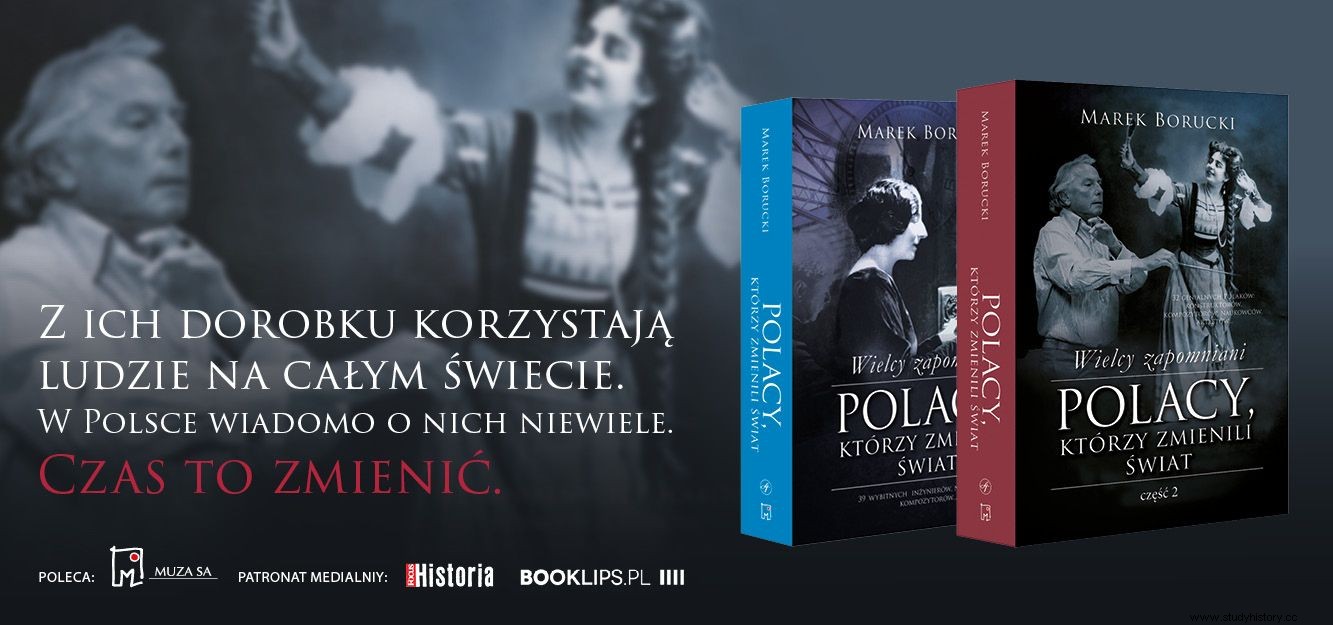They belonged to a small group of the most outstanding Polish scientists. During the day, they constructed inventions, conducted research, and expanded the kingdom of reason. In the evening ... they summoned ghosts. Were they fools? Or maybe we are the ones laughing at what they were doing?
What we know is a drop, and what we don't know is a sea a Latin proverb says. This observation is the starting point for all scientists. Most, however, stick firmly to what can be touched, measured, estimated. Majority. And not necessarily in Poland.
The fashion for seances and clairvoyance took Polish elites by storm in the 19th and 20th centuries. Also the intellectual elite. The triumphs were celebrated by the so-called mediumism . The term was coined by Julian Ochorowicz and, as Marek Borucki writes in his book "The Great Forgotten Poles who Changed the World", it meant studying the reaction of a person under the influence of hypnosis in a psychic trance.
With regard to the "scientists" carrying out such "research", one could recall yet another Latin sentence: the handicap of the epoch, not of people. But are you sure that their controversial interests were… so irrational?
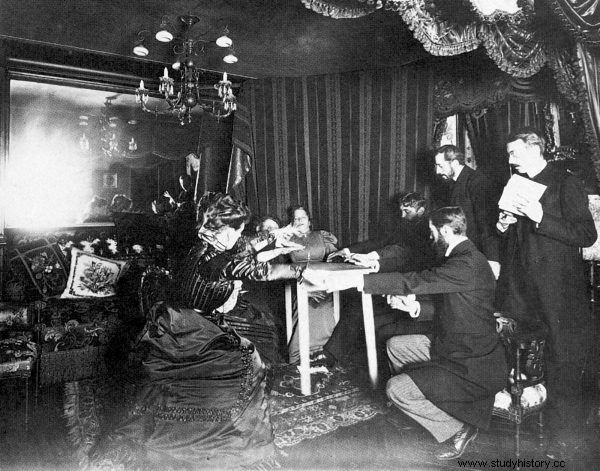
In the nineteenth and twentieth centuries, spiritualist sessions were held in all salons of Europe. Poles are also crazy about this exciting entertainment (source:public domain).
Fashion has floating tables
The aforementioned Ochorowicz did not only deal with defining magic tricks. He was a real Renaissance man. Borucki assigned him at least twelve professions. He was: a philosopher, psychologist, educator, doctor, radio electrician, writer, creator of parapsychology, occultist, positivist theorist, organizer of tourism and leisure, photographer, manager .
And all this at a time when it was not easy for even the most resourceful Poles to achieve something - Ochorowicz was born in 1850 and died shortly before Poland regained independence.
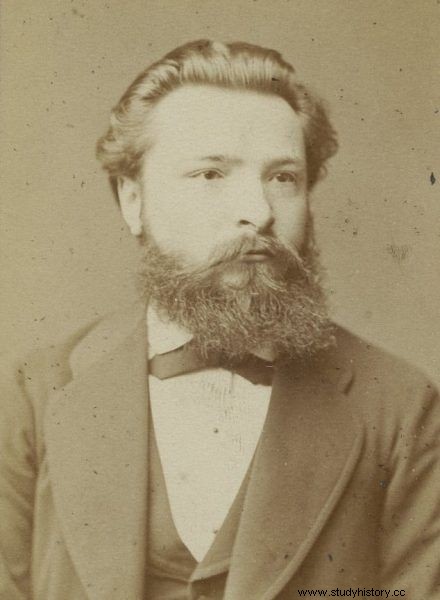
Julian Ochorowicz was the prototype for the character of Julian Ochocki in "The Doll", a novel by his friend Bolesław Prus. In addition to constructing practical inventions, he devoted a lot of time to another passion - the study of mediumism (source:public domain).
Ochorowicz was interested in electroacoustics , among other things , that is, the conversion of voice waves into electric current and vice versa. He worked on perfecting Bell's invention with considerable success. He displayed the telephones he constructed throughout Europe, even connecting to places located 320 kilometers away.
Together with Jan Szczepanik, known as the "Polish Edison", worked in Lviv on a TV prototype , based on self-created structures that use selenium. The scientist concluded that if electricity can produce heat and light - conversely, light and heat can produce electricity.
Around this time, the construction using the selenium plate was patented by other scientists and they are considered the precursors of television. And Ochorowicz's cooperation with Szczepanik fell apart, probably due to the incompatibility of characters.
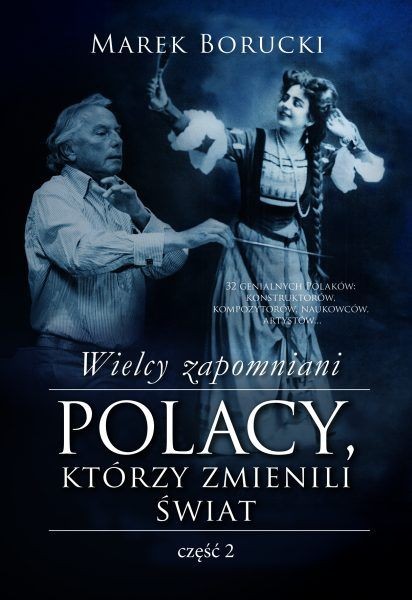
In addition to inventions accelerating the development of modern communication, Ochorowicz was passionate about something else - hypnosis and mediumism . The Vistula, which he popularized as an excellent holiday resort, turned into an esoteric center.
He lunged at every famous medium he had heard of with real fervor. He brought Eusapia Palladino from Rome to Poland, whom he met in the villa of the painter Henryk Siemiradzki. This simple Italian woman enjoyed enormous popularity at the time, and her phenomenon was studied by many scientists, including the philosopher Henri Bergson. During the sessions, she made contact with ghosts, made objects levitate, furniture moved, and ectoplasm was supposed to come out of her mouth .
Ochorowicz invited his friend Bolesław Prus to the screening, whose skepticism was to confirm the authenticity of paranormal events. The writer personally held the medium on a chair to prevent any machinations. Prus could not find a deception, although his rational nature refused to acknowledge the supernatural nature of the experience. Apparently, the sessions with Madame Palladino gave him a long time.
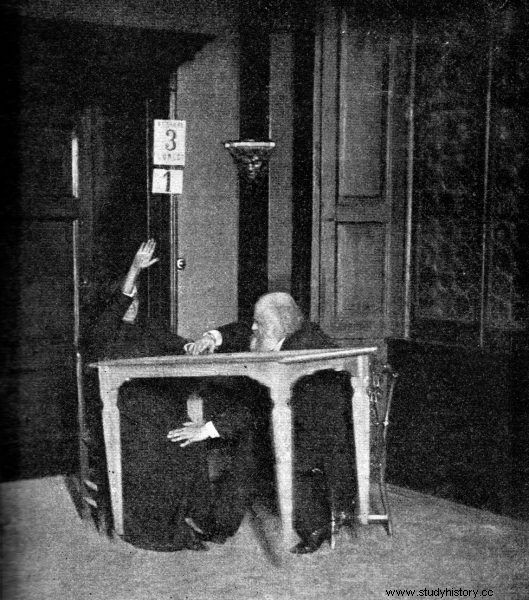
Eusapia Palladino during a seance. She is bravely assisted by Aleksandr Aksakov, checking if she is committing the classic fraud with raising the table with his knee (source:public domain).
Sam Ochorowicz admitted in "Psychic phenomena" that the Italian woman sometimes used a trick. However, this did not dampen his enthusiasm. He got involved with another medium, Stanisława Tomczyk. In addition to telekinetic abilities, her specialty was creating an astral double woven from fluidic matter . This figure was about half a meter tall, which is why it was called ... Little Stasia.
Even before the First World War, he also engaged another medium with clairvoyant abilities - Jadwiga Domańska. Long after Ochorowicz's death, she maintained that she was in constant contact with him.
All these searches were not simply sensationalists. And even more so - from genuine faith in the possibility of contact with ghosts. Ochorowicz was, after all, a rational scientist. And in his opinion, spiritism could be explained without resorting to any metaphysical argument ...
This article has more than one page. Please select another one below to continue reading.Attention! You are not on the first page of the article. If you want to read from the beginning click here.
Ochorowicz created the theory of ideoplasty, that is, the causative power of thought. According to it, under appropriate conditions (for example, in a state of hypnosis), mental energy loses its relationship with the body due to the split of forces from the tissues and causes the materialization of this image.
This is because, Ochorowicz argued, we have an etheric body. In the light of this explanation, psychic phenomena are not supernatural phenomena, but only a yet unknown type of psychophysical phenomena ...
Unknown - which must be emphasized - not only a century ago, but also today.
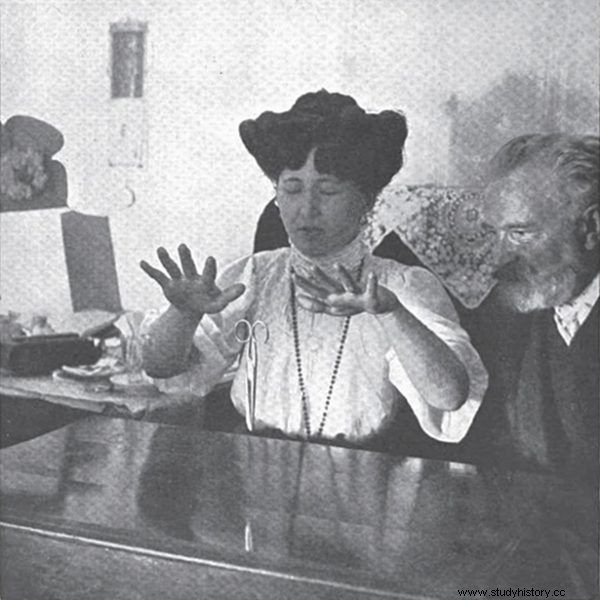
Stanisława Tomyczyna not only had the ability to telekinesis, but even managed to create her own astral double! Or at least she convinced Ochorowski about it ... (source:public domain).
Röntgen rays and ectoplasm
Another scientist, engineer Piotr Lebiedziński, shared his interest in parapsychology with Julian Ochorowicz. This chemist, inventor and constructor, who was also a pioneer of Polish cinematography and the photographic industry, was also charmed by the magic of flying tables .
And his scientific and design achievements predestine him to be called a serious scientist. He was interested in the so-called "live photography" that allows you to capture the movement. In 1895, in collaboration with Jan and Józef Popławski, he constructed the so-called "Lebiedziński's cinematograph" - a combination of a camera that allows the recording of 14 frames per second, with a projection apparatus displaying a moving image.
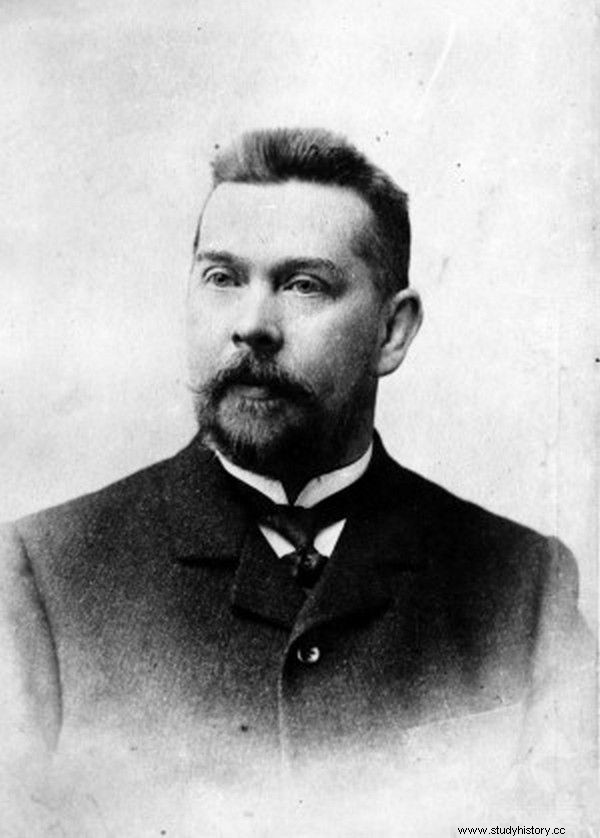
Piotr Lebiedziński, a pioneer of Polish cinematography and photography, was also the first man in the world to take a sample of ectoplasm! (source:public domain).
He was a man of versatile interests. In 1896 he made the first pictures in Poland using X-rays (Dr. Edmund Biernacki did it at the same time). He worked on the improvement of the turntable, was interested in the design of submarines, and constructed an apparatus for recording deformations of railway rails during the passage of a train. Together with the engineer Stanisław Śliwiński, he also built a projection cinematographic apparatus called "Cykloskop".
He was also a gifted entrepreneur. In 1890 he founded the first photographic paper factory in the country, producing photosensitive materials and cameras. The quality of his products was so high that Lebiedziński's paper was exported to Berlin, Vienna, Paris and London.
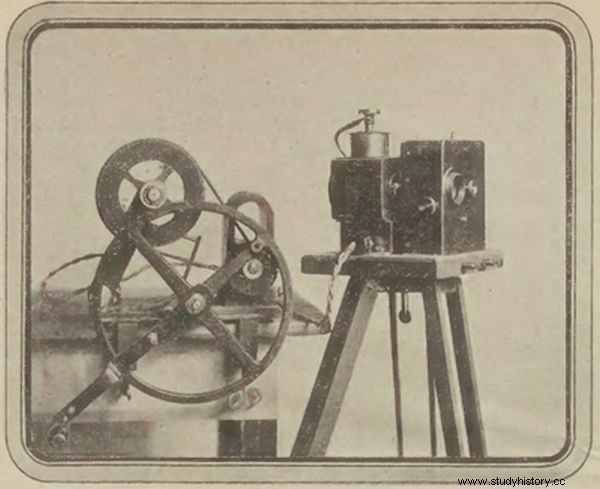
One of the numerous inventions of Piotr Lebiedziński was the "Cycloscope" (source:public domain).
When the Polish Psychiatric Research Society was established in 1920, Lebiedziński immediately joined. No wonder - his fascinations with psychokinesis and ectoplasm were known . In 1916 it was Lebiedziński - a serious entrepreneur and genius constructor - was the first in the world to take a sample of ectoplasm! It came from a well-known medium at the time, Stanisława Popielska.
He also creatively developed Ochorowicz's theory of ideoplasty . He divided paranormal phenomena into three categories:the ideoplasty of personality, matter and energy.
In the first case, the phenomena appearing during the session are a product of the psychic of the medium, in the second - they are the so-called apparitions of people or objects (but not ghosts! At such a statement, the scientist would probably be indignant. Let's be serious…). The third type includes energetic phenomena such as levitation of objects, strange noises, knocks, etc.

While there are many objections to these "scientific methods" and the attempts at ordering paranormal phenomena, it must be remembered that our great-grandparents lived in very peculiar times. It was an era full of discovering new forces, waves and phenomena. Breakthrough inventions undermined everything that previous generations knew about the tangible world.
It seemed that one step more would be enough and any supernatural phenomena could also be included in physics textbooks.
This article has more than one page. Please select another one below to continue reading.Attention! You are not on the first page of the article. If you want to read from the beginning click here.
This feeling was perfectly captured by Tadeusz Boy-Żeleński. The famous journalist wrote: I have never dealt with mediumism. Not that I don't believe it; that would be a bit of what not to believe in radio telegraphy .
From radio and television to distance hypnosis
Indeed, the path from radio wave science to spiritism has proved to be surprisingly short. An example is Stefan Manczarski. As a student, he experimented in the field of radio broadcasting and was the author of his first inventions - Marek Borucki writes about him in the book "Great Forgotten Poles who Changed the World". - In 1922 he constructed the first tube radio receiver, and soon the first Polish antenna designs.
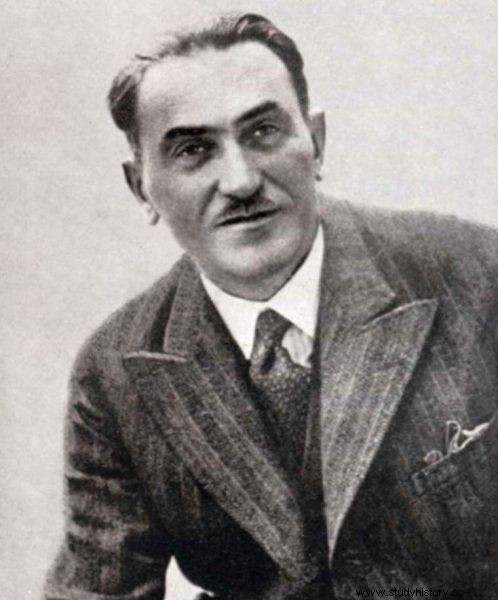
“I have never dealt with mediumism. Not that I would not believe it; it would be a bit of what not to believe in radio telegraphy "- wrote Tadeusz Boy-Żeleński (source:public domain).
In 1929 he created and patented the television apparatus . Using his discoveries, work began on launching the first Polish TV station. Test transmissions in the building of the "Prudential" skyscraper in Warsaw with the participation of Mieczysław Fogg took place in 1938 and 1939. The plans for permanent broadcasting were interrupted by the war, during which the scientist helped the Home Army to establish communication with the West .
After the war, he lectured at the Warsaw University of Technology, Military University of Technology, was the director of the Geophysics Department of the Polish Academy of Sciences, and obtained the title of full professor.
This brilliant Polish constructor and recognized scientist had other interests as well. He dealt with the propagation of radio waves around the Earth and in space, the influence of electromagnetic waves on living organisms and, attention, telepathic transmission of information .
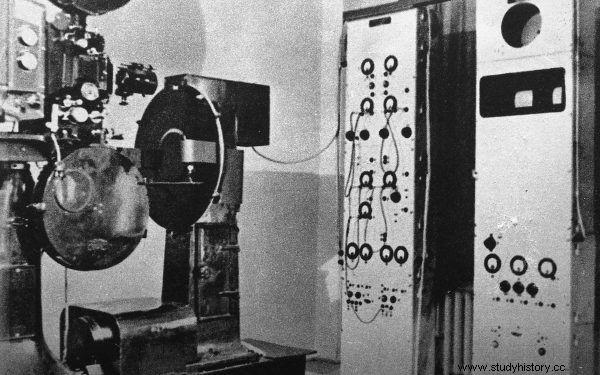
On the basis of Manczarski's 1929 "method of transmitting images via wire and radio" (as defined by the author himself), the equipment for the Experimental Television Station in the Prudential skyscraper was later developed (source:TVP archives, license:CC BY-SA 3.0) .
He formulated the hypothesis that remote hypnosis is possible . He believed that everyone has something like a relay antenna that you just have to be able to control. He claimed that it was possible to use these powers through television - he believed that through a television set one could hypnotize, heal or change the mood.
in 1963 as the dean of the first in Poland Faculty of Cybernetics at the University of Warsaw organized a research block on the phenomenon of telepathy . He conducted tests with students to prove the possibility of transmitting signals and images without the use of technique.
Another problem engulfing the professor was the phenomenon of psychometry - writes Marek Borucki. - The hypothesis formulated by him is that a particularly sensitive person who touches an object is able to reveal who previously touched it . A person with psychometric giftedness analyzes a chemical trace, for example a skin secretion, or an energetic trace of acoustic, magnetic and other shock waves.
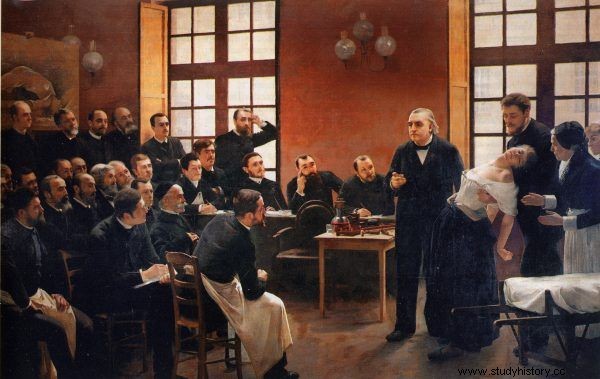
The history of research on hypnosis dates back to the turn of the 18th and 19th centuries. With the development of technology, it was recognized that hypnotizing can also be done using TV transmitters. In the painting by Jean-Martin Charcot, a hysterical patient is treated with hypnosis (source:public domain).
To this day, many respected scientists work in fields classified as para-sciences. Just as people of the coal and steel age were quite seriously associated in organizations such as the Cambridge Ghost Society (bringing together chemists, biologists and physicists), today scientists at renowned universities work on issues that we automatically shrug off.
And maybe it doesn't make any sense at all? Let's wait, maybe it turns out that each of us has a built-in antenna…
Bibliography:
- Augustynek Andrzej, Julian Ochorowicz (1850-1917) - a precursor of clinical psychology and experimental hypnosis , access:April 21, 2016.
- Borucki Marek, Great forgotten Poles who changed the world , publishing house MUZA 2016.
- Sołowianiuk Paulina, A clairvoyant in the living room, or spiritism and paranormalism in interwar Poland , Iskry 2014 publishing house.
- Aleksander Żakowicz, Piotr Lebiedziński (1860–1934) , "Scientific works of the Jan Długosz in Częstochowa. Art education. Photography ”VII, p. 42, 2012.
You can buy Marek Borucki's book at a discount at empik.com
